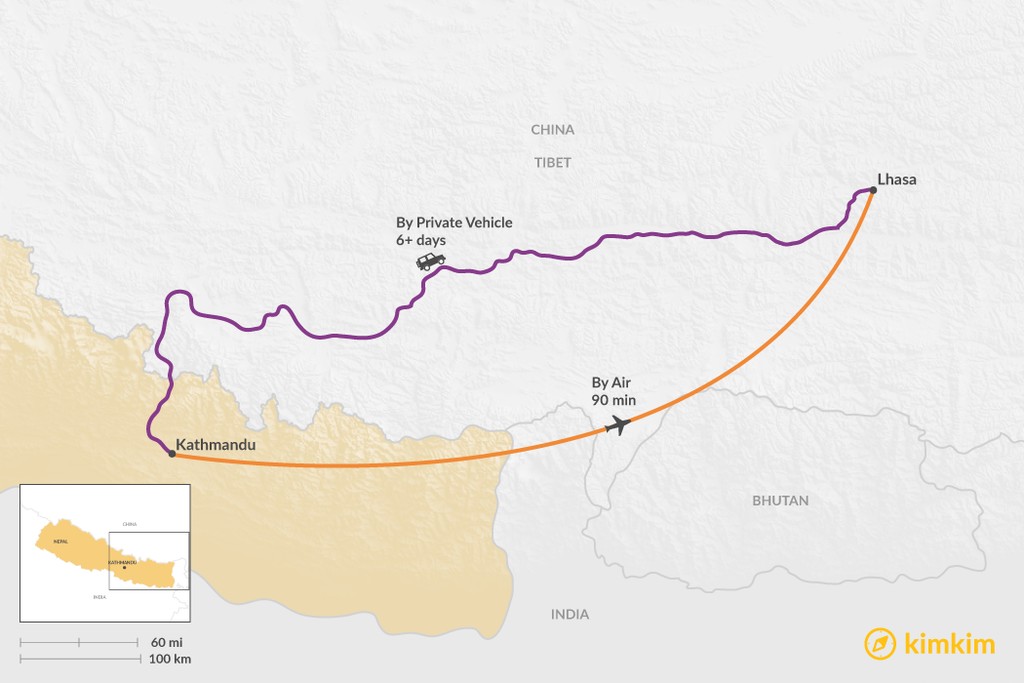
How to Get from Kathmandu to Lhasa

Lhasa, the capital of Tibet, is 376 miles (606 km) northeast of Kathmandu, and there's a very large mountain range in between: the Himalaya. The easiest way of making the trip is to fly, but some travelers enjoy the experience of going overland. Here's what you need to know about getting from Kathmandu to Lhasa.
By Air
Duration: 90 minutes
There are daily flights between Kathmandu and Lhasa, operated by Chinese airlines. The flight is a short 90 minutes, and extremely scenic, as it crosses the Himalaya and the high Tibetan Plateau. You might even see Mount Everest, depending on which side of the plane you're seated on, and the flight route on the day.
The journey can be quite turbulent, as winds whip across the Tibetan Plateau and off the mountains. Nervous fliers may want to practice some deep breathing exercises!
There's a 2.25 hour time difference between Kathmandu and Lhasa, so you'll lose a bit of time on your first day in Lhasa. If you leave Kathmandu in the early afternoon, by the time you get to your hotel in Lhasa it'll be evening. This isn't such a bad thing, as you're advised to take things easy after arrival in Lhasa. The city is at 11,990 feet (3656 m), which is a big jump from Kathmandu's 4,593 feet (1,400 m).
By Private Vehicle
Duration: 6+ days
It's important to seek the most up-to-date information as possible before planning to go overland between Kathmandu and Lhasa.
At the time of writing, the Nepal-Tibet border at Kyirong/Rasuwagadhi is open. There are other borders, but not all of them are open all the time, and not all are open to non-China or non-Nepal-passport holders. The main Nepal-Tibet border, at Zhangmu/Dram, was closed for a couple of years after the 2015 earthquake in Nepal, and the Chinese authorities also periodically shut the border with little or no warning for reasons that may or may not be stated. Sometimes the closure is practical, sometimes political. When planning an overland trip, be aware that you may end up needing to fly if the situation changes.
Kyirong/Rasuwagadhi is about 93 miles (150 kilometers) northeast of Kathmandu, along the Pasang Lhamu Highway. The road passes through Dhunche and Syabrubesi, the starting point for the Langtang Valley trek and other treks in the Langtang area. The journey to the border will take a minimum of 8 hours. The roads are slow, twisting and mountainous, and in some places are nothing more than a dirt track. When there has been rain, such as during Nepal's monsoon, the journey may take two days or more.
While it is possible to take a bus or shared vehicle to the border and then meet with a pre-arranged guide and driver once on the Tibetan side, we recommend taking a private vehicle. The condition of the roads in this area makes buses uncomfortable, unsafe, and slow.
You will need to change vehicles at the border. As almost all foreign travelers need to travel to Tibet with a guide on a tour, the arrangements will be taken care of for you and you'll be instructed where to go and what to do at the border.
From the border, Lhasa is still a long way away. The road conditions are markedly better in Tibet than they are in Nepal, so if you wanted or needed to go directly to Lhasa the journey would take you around 12 hours. However, most travelers join tours that stop at various points of interest along the way, taking several days to reach Lhasa. Popular places to stop include Everest Base Camp on the Tibet side and the towns of Tingri, Shigatse, and Gyantse.
